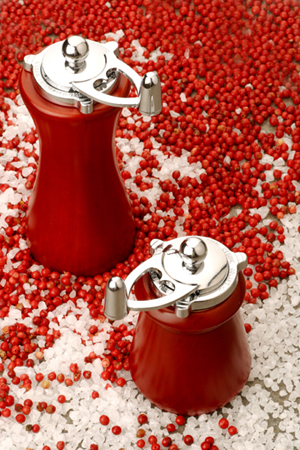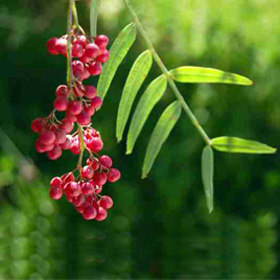 |


Pink peppercorns galore, plus sea salt, make for great seasoning. Peppermills available from WilliamBounds.com. |
| WHAT IT IS: Varietal peppercorns—20 different pepper types and counting. |
WHY IT’S DIFFERENT: Each origin of the world produces pepper with different aromas and flavors—just like coffee beans and chocolate. |
| WHY WE LOVE IT: Another way to vary food accents—and it has no calories! |
| WHERE TO BUY IT: Pepper-Passion.com, Kalustyans.com. |
| All of the Top Pick Of The Week newsletters are permanently archived on TheNibble.com, in chronological order and by product category. |
|
|
 |

Varietal Peppercorns:
Spice Up Your Life
Page 2: What Is Pepper?
What Is Pepper
Black pepper, botanically known as Piper nigrum, from the family Piperaceae, has been the world’s most popular spice for 3,000 years, treasured by ancient Egyptians, Greeks and Romans—the pharaohs were buried with precious peppercorns in their noses. For much of its history, pepper was known as “Black Gold,” a term still used in India today. Native to the western hills of India, traders carried pepper to Java and other countries. It was so treasured that the search for its source and control of the trade influenced world exploration, and thus, history. Vasco da Gama circumnavigated Africa to reach the Malabar Coast of India, which enabled Portugal to gain a monopoly on pepper for almost a century. That made Lisbon the European trading center for spices, nearly ruining Alexandria, Genoa and Venice.
Pepper was of key importance to season and preserve meats, and to overcome the odors of rancid food. By the Middle Ages in Europe, pepper was so valuable that it was worth more than gold by weight, and individual peppercorns were widely accepted as legal currency for dowries, taxes and rents. It was also gold for one’s health. The original pepper merchants, along with spice merchants, were the predecessors of apothecaries: Pepper and pepper oil were components of most European medicines of the time.
(Article continues below)
|
Article Index
This is Page 2 of an 11-page article. Click on the black links below to visit other pages.
|
|
What Is Pepper (Continued)
Pepper comprises more than 25% of the world trade in spices, yet is grown in only a handful of countries within 15 degrees of the equator. The word pepper derives from the Sanskrit pippali, which referred to the long pepper, piper longum; the word for the round Piper nigrum is marica. However, the Greeks and Romans adapted pippali to refer to either pepper: In Latin the word became piper and in Old English, pipor.
All true peppercorns are produced from the berries of Piper nigrum, a tropical flowering vine native to South India and now grown in other humid, tropical environments. A woody evergreen that grows to 11 yards or more in length, the pepper vine uses aerial roots to cling to, and climb, trees. When it is cultivated, the vine is terraced, similar to grape vines.
Peppercorn plants blossom into small white flowers that bloom in clusters of up to 150 florets and hang down a spike. The flowers yield to fruit, the red berries shown in the photo at right. Each berry contains a single, large seed (the peppercorn). The same fruit is used to produce black, white and green peppercorns, but each is harvested and processed differently, as you’ll read in the Glossary of Varietal Peppercorns.
|

The berries of the peppercorn plant are dried and
processed into peppercorns: The actual corn is the
seed of the berry.
|
As with wine, coffee, chocolate, cheese and many foodstuffs, country and region of origin are important to the quality of the product, both for the growing environment (“terroir”), which imparts different flavor qualities, and the craftsmanship of the producers. As connoisseurship of peppercorns grows, individuals will find their taste preferences, whether they be the floral Sarawak from Malaysia, the super-hot Talamanca del Caribe from Ecuador or something else entirely.
By the way, the use of the word “pepper” to mean “spirit” or “energy” dates at least as far back as the 1840s: In the early 20th century, it was shortened to “pep.”
Continue To Page 3: What’s Wrong With Supermarket Pepper
Go To The Article Index Above
FOR ADDITIONAL INFORMATION, special offers,
contests, opinion surveys, THE NIBBLE
back issues archive, product gift-finder and more,
visit the home page of TheNibble.com.
Do you have friends who would enjoy THE NIBBLE?
Click here to send them an invitation to sign up for their own copy. |
ABOUT THE NIBBLE. THE NIBBLE™, Great Food Finds™, is an online magazine about specialty foods and the gourmet life. It is the only consumer publication and website that focuses on reviewing the best specialty foods and beverages, in every category. The magazine also covers tabletop items, gourmet housewares, and other areas of interest to people who love fine food.
© Copyright 2004-2025
Lifestyle Direct, Inc. All rights
reserved. All information contained herein is subject to change at any time
without notice. All details must be directly confirmed with manufacturers, service
establishments and other third parties. This material may not
be reproduced, distributed, transmitted, cached, or otherwise used, except with
the prior written permission of Lifestyle Direct, Inc.
|
 |
|
 |